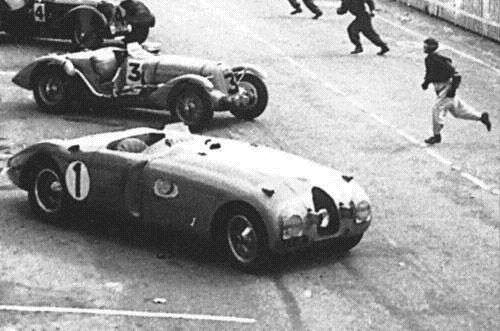Quote:
|
And lest anyone think those speeds were low:
|
LOL, I think that picture is misleading. I don't mean to jump all over you here but just looking carefully, the frontwards skew is either a lens aberration or a darkroom trick. If we knew the shutter speed, we could figure out the speed it was travelling. Just guessing using the specs from a Graflex of 1923 with a max shutter speed of 1/1000 s. If the shutter speed was 1/500 s and the blurr was about 2 inches then it would have been going 60 mph. At 1/1000 s the blur would have been 1" It looks less than that to my eyes.
Obviously, I have way too much time on my hands.
Since two of them are still racing in vintage days, it would be interesting to hear from those drivers. From what I've gleaned so far the top speed was about 117 mph and the average track speed was probably half that at best. Although lift would have probably had some negative effects, a lot of the weight on these cars is between the front wheels where most of the lift would be and it has been pointed out ad nauseum in other threads, at speeds below 100mph, lift is pretty much a minor issue. The short wheel base would probably have been it's real downfall.
One advantage in cornering is that the car would have had a much lower centre of gravity than the cars it was racing against which were very easy to rollover. This was probably offset by the twitchyness which would have been murder on the relatively rough tracks they drove on in those days.
Having said all that, which is just my side seat driver opinion, I agree that these cars would have been a hand full to race!
I think if Bugatti had stuck with that overall design and tweaked it, he would have dominated racing even more than he did with the type 35. As it is, 14 years later, he won both the 1937 and 1939 24 hours of Le Mans in the more rounded edge but longer wing shape type 57 S and a 57 G respectively. Each set a Le Mans record for
average speed in the mid to high 80mph
Since his main goal was to sell the cars he raced, I bet he took the negative reaction to the shape to be a marketing problem and returned to making fantastic engines for the more normal looking type 35. Fuel economy would not have been a factor to Bugatti or the wealthy who bought his cars.
I couldn't find the exact cars but this is a replica of the car that came in second at the 1937 Le Mans.

And a restored version of second place in the 1939 Race:

The type 57 G
The racing version did not have had the spare tire on the back

Added. Here is a photo of the start of the 1939 race with the actual cars:
